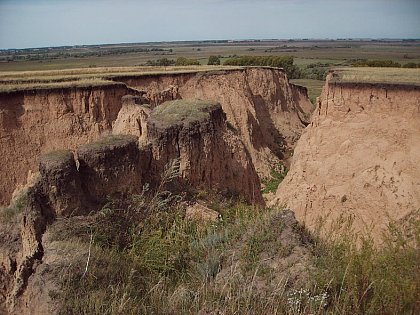Contact
Prof. Dr. Manfred Frühauf
phone: 0345 55 26040
manfred.fruehauf@geo.uni-ha...
Martin-Luther-University,
Halle-Wittenberg
Geo-ecology
06120 Halle (Saale)
Putting life back into the steppes
INES GODAZGAR
Of all places, Russia’s most important bread basket lies in the remote Western Siberian Steppe. The area is crucial for the government of this giant realm as it ensures harvests and safeguards the country from expensive imports. Yet the area is endangered. For decades the steppe’s soil has been destroyed by improper farming techniques and strong climate fluctuations. How and if it is possible to use the area more sustainably in the future while, at the same time, increasing yields is what Halle’s geo-ecologist, Professor Manfred Frühauf, is hoping to find out in the next five years as part of a joint research project.

Gully erosion is evidence of landscape destruction in the agricultural steppes of Southern Siberia (Photo: Manfred Frühauf)
Prof. Dr. Manfred Frühauf is excited: The Federal Ministry of Education and Research will grant the project around 3.2 million euros over the next five years to promote sustainable land use in the Kulunda Steppe. Money which is urgently needed if the ongoing destruction of the steppe soil is to be stemmed.
The area being studied – the Kulunda Steppe in Western Siberia belonging to Russia – is even today still partially settled by ethnic Germans. The importance of this landscape as a bread basket has steadily increased. So too because Russia has become smaller in size in past years. “The areas of land used for farming has shrunken dramatically since the Ukraine and Kazakhstan became independent,” says Frühauf.
Formerly a bread basket, now devastated soil
The Kulunda Steppe was first used for excessive wheat farming in the 1950s. Because his people were not getting enough to eat, former Soviet leader Nikita Khrushchev decided to cultivate around 420,000 square kilometres – an area the size of Germany and Austria put together. At first the plan was a success and the supply situation relaxed. However Khrushchev was not thinking ahead since the extent to which the bread basket was being used meant soil conditions deteriorated. The reason: unsuitable, non-sustainable use.
Frühauf, speaker for the joint project, knows the Kulunda Steppe like no other. For more than 20 years he has maintained close contact with researchers in Barnaul, a university city located in the foothills of the Altai Mountains on the border to Kazakhstan. He’s seen the oppressed soil with his own eyes: continuous ploughing has left behind deep plough furrows.
The harsh climate has also ensured that the soil quickly dried out and the ground has split open. “Because of this, the humus underneath has blown away. The result was massive soil erosion,” Frühauf explains. The main question of his work is therefore: what can we do with such eroded soil? “We have to look for usage strategies that are also suitable for the change in climatic conditions,” says the 61-year-old.
Yet it’s about more than just that: we also need to contribute to reducing greenhouse gases. Soils are the most important carbon storage units in the world. If they are excessively processed, the carbon is released and produces carbon dioxide when it binds with oxygen. If we are able to retain more carbon in the soil, we will be protecting the environment at the same time.
Currently diverse trials are being carried out in the Kulunda Steppe. Scientists are experimenting with five different processing sequences and crop rotations. In doing so, an increased amount of organic substance is being introduced into the soil so that nutrient-rich humus can reform. Furthermore conventional ploughs have nearly completely been done away with. Instead, the seeds are planted meticulously in only three to five centimetre deep furrows. Initial results reveal that the soil is recovering and that harvest yields can actually increase thanks to the more nutrient-rich soil.
Seems simple enough, however it is hard to implement. The scientific findings alone are not sufficient to halt the destructive process of soil erosion. The findings must also be accepted by local farmers. “They need to acquire new agricultural machines in order to work according to these new methods,” Frühauf explains. “However they will only do this if they are convinced that the investment makes sense.”
Only after the farmers realize that yields can actually increase will they take out a loan to buy new equipment. “So it’s about convincing them,” says Frühauf. Various German universities, non-university research institutes and Russian partners are participating in the project. He also sees this as a way to help the people help themselves. After the scientists leave in five years, the new farming methods in the Kulunda Steppe have to work on their own.
If everything goes to plan every participant will be able to take something away from the Kulunda Project: The local people will have higher harvest yields, the scientists will have their findings and, through the positive effects on the climate, the world will also profit, so to speak. “That is true sustainability,” Manfred Frühauf believes.
Sustained teaching in Africa
Sustainability can also be achieved in teaching. An example where this has been successful is a DAAD project carried out by Prof. Manfred Frühauf in Africa. The aim is to export to developing countries experience in communicating scientific knowledge. This saves on resources and helps others to help themselves. As part of the project, teaching modules are being developed for teaching geography at universities in South Africa and Swaziland. They should help African students, who are equipped with various levels of knowledge and have received a more theoretical education, to use their knowledge in a practical way outside the lecture hall. They learn how to take soil samples, carry out analysis and draw conclusions about the causes of impurities or the configuration of watering holes in rivers. This, in turn, improves the education and living situation of the local people. Ines Godazgar



